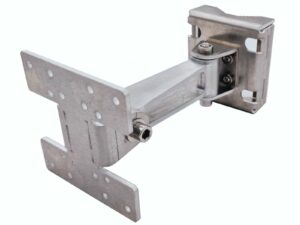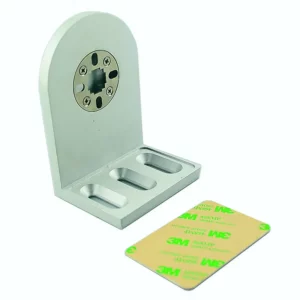At Davantech, among other products we also do aluminum mounting brackets manufacturing. Our customers use these brackets to mount window blinds, hand rails and electronic devices. Next to aluminum we also make brackets in stainless steel. Different mounting brackets are manufactured in different ways.

Manufacturing Aluminum Mounting Brackets
Aluminum brackets usually consist of extruded and machined aluminum parts, as well as sheet metal parts. Next, we do the surface treatment such as anodizing or powder coating. Then, we do the final assembly.
Aluminum brackets play a crucial role in various industries, from construction to automotive, providing a good mounting of electronic devices and other products. Manufacturing these brackets involves several key processes, including CNC machining, sheet metal parts manufacturing, extrusion, and casting. Each process contributes to the production of high-quality and precise brackets that meet industry standards and customer requirements.
CNC Machined Parts
CNC machining is a versatile and widely used technique in aluminum bracket manufacturing. It utilizes computer-controlled machines to remove material from aluminum blocks, creating the desired shape and dimensions. The CNC machines employ various cutting tools, such as drills, mills, and lathes, to shape the brackets with exceptional accuracy. This process allows for the production of brackets with complex geometries and tight tolerances.
Using Aluminum Sheet Metal parts
Sheet metal parts manufacturing is another integral aspect of aluminum bracket production. This process involves shaping and forming thin sheets of aluminum into specific bracket designs. Sheet metal is cut into the desired shape, and then bending, folding, and welding techniques are used to achieve the final bracket form. It is a cost-effective method that offers flexibility in design and customization, making it suitable for both small and large-scale production.
Extrusion in Combination with Milling

Extrusion is a popular method for creating aluminum brackets with uniform cross-sections. In this process, aluminum billets are heated and forced through a die using high pressure. The die has a cross-sectional shape that matches the desired bracket profile. As the aluminum passes through the die, it takes on the shape of the die, resulting in long, continuous profiles. These profiles are then cut into individual brackets of the required length. Extrusion is an efficient process that allows for the production of brackets with consistent dimensions and excellent structural integrity.
Casting Aluminum Components
Casting is another technique employed in the manufacturing of aluminum brackets, especially for complex designs and large quantities. It involves pouring molten aluminum into a mold cavity, which is shaped like the desired bracket. Once the aluminum cools and solidifies, the mold is removed, leaving behind a finished bracket. Casting offers great design flexibility and enables the production of intricate details and features that may be difficult to achieve with other manufacturing methods. It is particularly suitable for brackets that require high strength and durability.
When it comes to the selection of the manufacturing process for aluminum brackets, various factors are considered, including the complexity of the design, the required strength and durability, cost-effectiveness, and production volume. CNC machining is often preferred for intricate designs and low to medium production volumes, as it offers precise control over the manufacturing process. Sheet metal parts manufacturing is ideal for simpler bracket designs and customization options. Extrusion is chosen for brackets that require uniform cross-sections, while casting is suitable for complex designs and large quantities.
Quality control is an essential aspect of aluminum bracket manufacturing. Throughout the production process, rigorous inspections and measurements are conducted to ensure that the brackets meet the required specifications. This includes dimensional accuracy, surface finish, strength, and overall functionality. Specific measuring tools and non-destructive testing methods are employed to verify the quality of the brackets and identify any defects or deviations.
Surface Treatment of Aluminum Brackets
Furthermore, surface treatment and finishing processes are often applied to aluminum brackets to enhance their appearance and protect them from corrosion. Common surface treatments include anodizing, powder coating, and painting. Anodizing forms a protective oxide layer on the surface of the brackets, providing increased resistance to corrosion. Powder coating and painting offer decorative options as well as added protection against environmental factors.
In conclusion, aluminum brackets are vital components in various industries, and their manufacturing involves a combination of processes such as CNC machining, sheet metal parts manufacturing, extrusion, and casting. Each method offers unique advantages depending on the design complexity, production volume, and desired characteristics of the brackets. Quality control measures and surface treatments ensure that the brackets meet industry standards and customer expectations. By utilizing these manufacturing techniques, aluminum brackets
Davantech does more than aluminum mounting brackets manufacturing. We are located in Europe and our factory is based in Dongguan, China since 2012. We also provide product engineering services. Our factory covers an area of over 1000 square meters. We obtained ISO 9001:2015 certification in 2018. One of our specialties is CNC turning, CNC milling and CNC machining. Surface finish such as powder coating and anodizing is possible. One of our benefits is assembling services for small or large volumes and this for a variety of markets. Whether the quantity is small or large, we have the capabilities of meeting our customers’ most demanding needs.